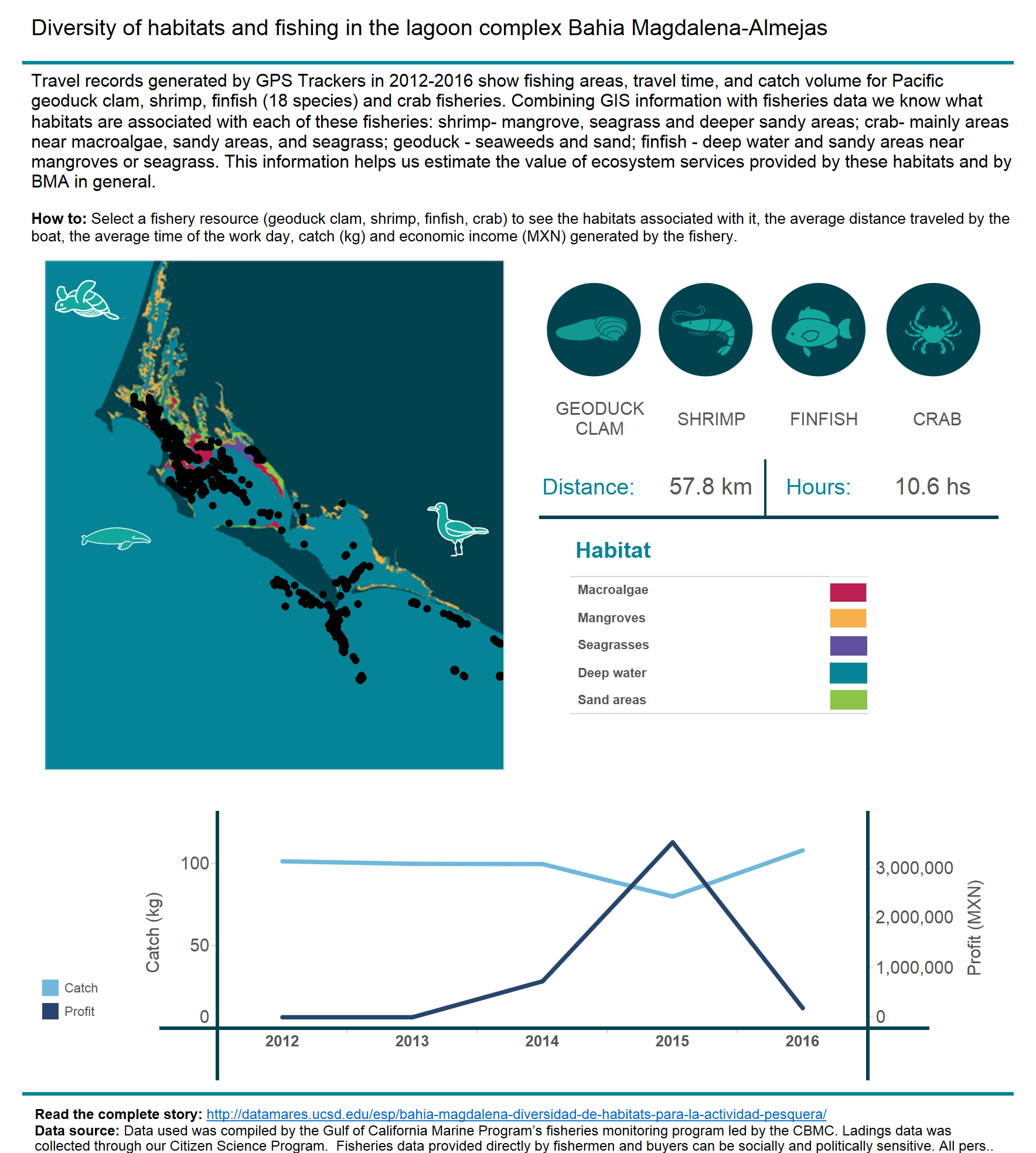Keywords:
Bahía Magdalena: habitat diversity sustains fisheries.

The lagoon complex Bahia Magdalena-Almejas (BMA) is one of the most biodiverse lagoon ecosystems in the state of Baja California Sur, making it an attractive location for ecotourism and fishing. High productivity prevails most of the year as a result of the diversity of marine and coastal habitats: mangroves, dunes, sand bars, islands, deep water areas, seagrass beds and a network of canals (1). Moreover, this diversity of habitats attracts protected species such as gray whales and sea turtles, and it’s also an important breeding and feeding site for birds (2). The communities of BMA depend on marine resources for their survival, therefore understanding the relationship between fisheries and the ecosystem will help us understand the impact that fisheries have on the performance of other economic activities (Eg. ecotourism) that take palce in the same areas.

Using GIS mapping techniques, we identified the distribution of fishing activity, while fishermen helped us record fish catches and income for each fishery. The innovative use of technology has become fundamental to the study of fisheries. We use the descriptions of marine habitats made by Rioja-Nieto et al (5) and GIS information on mangrove forests from the National Commission for Knowledge and Use of Biodiversity (CONABIO) to show the different habitats in BMA (6). In addition, we conducted 100 interviews with fishermen to: a) validate fisheries information generated since 2012 with GPS Tracker devices; and b) identify important areas for priority species (whales, sea turtles, and nesting and feeding seabirds).
Major Findings
We identified about 2,000 fishing areas and have more than 1,500 records of fish catches for the most important coastal fisheries in BMA: Pacific geoduck clam, shrimp, crab and finfish (18 species). Together, these coastal fisheries generated 3.05 million pesos from 2012 to February 2016. We calculated the average time (hours) and distance (km) of fishing trips for each fisheries resource. For example, the longest and shortest work days we identified were both in the finfish fisheries: 192 km and 14 hours, and 3.4 km and 5 hours, respectively. With this information we can understand the effort required and costs incurred by fishermen to capture different resources.
We identified five types of habitats associated with these fisheries: 1) mangroves; 2) macroalgae; 3) seagrass; 4) sandy areas; 5) deep water areas. The Pacific geoduck is associated with macroalgae and sandy habitats. Shrimp are caught in areas close to mangroves, seagrass beds, and sandy areas ranging from 6 to 50 meters deep. Our information indicates that crab is caught in areas close to the mangroves and canals with abundant seagrass. To catch different species of finfish, fishermen travel to both deeper waters, as well as waters close to the mangrove.
Authors:
J. José Cota-Nieto, Victoria Jiménez-Esquivel, Ismael Mascareñas-Osorio
Contact Information:
juan.jose@gocmarineprogram.org
DOI:
10.13022/M3HP4F
Affiliations:
Centro para la Biodiversidad Marina y la Conservación A.C., La Paz B.C
Acknowledgements:
N/A
How to cite this story:
J. José Cota-Nieto, Victoria Jiménez-Esquivel, Ismael Mascareñas-Osorio (2016): Share Bahía Magdalena: habitat diversity sustains fisheries. DataMares. InteractiveResource. http://dx.doi.org/10.13022/M3HP4F
References
- Ojeda, M.A. 2012. Interacciones entre pesquerías ribereñas en Bahía Magdalena-Almejas, B.C.S. México. Tesis de doctorado. Centro Interdisciplinario de Ciencias Marinas, Instituto Politécnico Nacional. México. 128 p.
- Hastings R. M. and Fisher D.W. 2001. Management priorities for Magdalena Bay Baja California, México. Journal of Coastal Conservation, 7: 193-202.
- https://datamares.org/esp/la-pesca-en-bahia-magdalena-almejas-motor-economico-para-b-c-s/
- https://datamares.org/esp/movimiento-de-las-pangas-rastreando-a-los-pescadores-mexicanos/
- Rioja – Nieto, R., Barrera – Falcón, E., Hinojosa – Arango, G. y Riosmena – Rodríguez, R. 2013. Benthic habitat b-diversity modeling and landscape metrics for the selection of priority conservation areas using a systematic approach: Magdalena Bay, Mexico, as a case study. Ocean and Coastal Management, 82: 95 – 103.
- http://www.conabio.gob.mx/informacion/gis/

